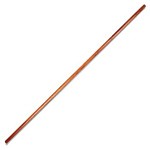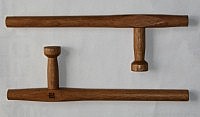![]()
Kobudo
| "Kobudo" are traditional, armed martial arts having their origin on the island of Okinawa. You translate "Kobudo" as old ("Ko") martial ("Bu") arts ("Do"). The original term of these martial arts was "Kobu-Jutsu". |
|
| Kobudo uses various farmer, handcrafter, and fisherman tools as arms. In times of the Japanese occupation of Okinawa, the inhabitants of Okinawa had to pay high taxes, and it was forbidden to bear weapons under menace of draconian punishments. In order to be able to defend themselves against attackers (e.g. marauding samurai), however, they developed fighting techniques with simple appliances and tools over many centuries which were equal or even superior to many traditional weasons. These appliances did not have the character of weapons, however, and, thus, it was allowed to bear just those appliances. |
| Over many centuries, the techniques were passed on from generation to generation only within the families. Only in the 19th century, i.e. at the time of the social upheaval of Japan, the martial background of "Kobu-Jutsu" got lost and it fell slowly into oblivion. Successively, "Jutsu" ("martial fight") changed towards "Do" ("martial arts"), as it is known today under the term "Kobudo". |
| To all intents and purposes, today's Kobudo is a secondary sport indeed receiving its basis from Karate-Do. In order to be able to understand Karate-Do in all its diversity, one has to delve into Kobudo. |
| A lot of
weapons are trained in
Kobudo. The main weapons are: Bo (long stick with a length of approx. 182.5 cm),
Hanbo (short stick with a length of approx. 90 cm), Sai (fork with three prongs), Tonfa (elbow-length
stick with handle), Kama (reaping hook), and Nunchaku
(flail). It is
important to remark that Nunchaku is a forbidden weapon according
weapons legislation in Germany! However, there are a lot of subsidiary weapons. Some of them are: Kua (rake), Ieku (paddle or rudder), Tessen (iron fan), Jo (medium-length stick with a length of approx. 120 cm), Nunti (long spear), Sansetsukon (three-piece stick), Tinbe and Rochin (shield and short dagger), Tekko (brass knuckles consisting of two horseshoes), Suruchin (two weights connected by a chain or cord), and many others more. Tekko and Suruchin are also forbidden weapons according weapons legislation in Germany! |
| Many weapons are of Chinese origin. The inhabitants of the island Okinawa, who brought them into their homeland on the occasion of their trips to China, mastered these weapons with absolute perfection. |
| Our Dojo training involves all weapons, except the forbidden weapons. Owing to the complexity of the matter, only pupils with the 3rd Kyu (brown belt) and higher are allowed to participate in the training with weapons. Thus, it is guaranteed that an established basis in Karate-Do is already available. Additionally the pupils must be at least 21 years old. |
| The training structure in Kobudo is similar to the one of karate: Hojo-Undo (basic techniques), kata (forms), and kumi (partner practices) are trained. Special importance is attached to practising the kata techniques together with the partner (Bunkai). The partners may use the same or different weapons during their kumi training. Advanced kobudo pupils may also train the free fight (Jiyu-Kumi) with arms. |
| In the following, some illustrations of the most important weapons: |
 |
Bo
(Long stick) |
|
|
Hanbo
(Short stick) |
 |
Tonfa
(Crank Handle) |
|
|
Sai
(Sword breaker) |
|
|
Kama
(Hook) |
|
Video trailer kobudo presentation |